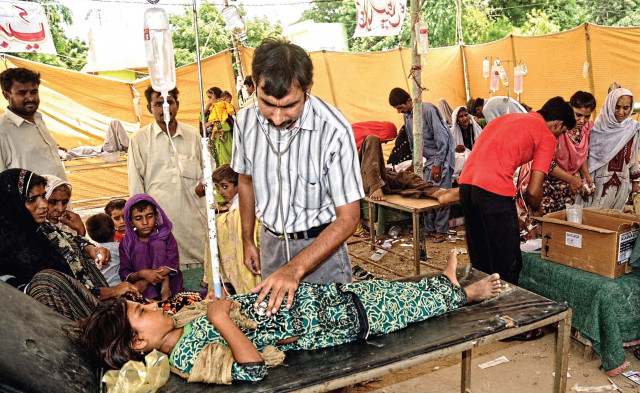Diabetes: The dreadful and the deadly
It was not easy for Ghulam Hussain to get used to his amputated leg, which he lost due to diabetes at the age of 45.

Diabetes: The dreadful and the deadly
“It all started with a toe injury, which I did not take much notice of. A week later when walking became painful, I was told by the doctor to get my big toe removed before the infection aggravated,” says Hussain. However, the contagion did not stop there and it mercilessly developed itself to the upper limb. “It eventually became inevitable that I had to get my leg amputated up till my thigh,” he sombrely added.
Epidemiologist and Bio Statistician Dr Shirin Mirza says that people with diabetes are 14 to 20 times more likely to require lower limb amputation as compared to those without diabetes. “Some patients who have a wound on the foot are sometimes diagnosed as having a diabetic foot. For a large number of patients, they are labelled as diabetic for the first time in their life,” she adds reflecting upon her practice as a Senior Instructor in Community Health Sciences.
For Hussain, his life’s gravest misery started when the amputation was followed by the loss of vision of his right eye as one of the complications of diabetes.
Diabetes or Diabetes Mellitus is fundamentally classified into two types. Type 1 is an insulin-dependent diabetes in which patients need to be injected with insulin to control the level of glucose in their blood. While Type 2 is usually substituted as non-insulin dependent in which the control over the glucose level depends more upon observing prescribed diet and necessary exercise than anything else. Diabetes can also occur in other forms as well, which remain too rare to be classified.
It is excessively clichéd that a person is prone to be diabetic because of heavy consumption of sugar. Owing to this reason, people having no signs of diabetes, avoid sweets so as to prevent contracting the disease. “No foods cause diabetes. This is probably the most common misconception about diabetes that an increased sugar intake will cause diabetes,” says Dr Aamer Imdad, a medical doctor at the Aga Khan University Hospital. As a matter of fact, getting the illness is associated with the production of insulin by the pancreas and not with the intensity of sweetness in eatables. In a diabetic condition, either pancreas does not produce the sufficient amount of insulin to convert the glucose into energy or the body itself is not able to consume the produced insulin appropriately. This subsequently leads to a rise in the amount of glucose (sugar) getting accumulated in the blood. This condition is technically conceptualised as hyperglycaemia or high blood sugar. “It is however important that when you have diabetes, you need to watch your sugar and carbohydrate intake,” he further adds.
A complete loss of vision, which is a case of retinopathy, does not remain the only complication to be developed following diabetes. “In later stages, diabetes also affects the heart, causing heart failure, and kidneys, causing chronic renal failure,” Mirza says. Additionally, as the World Health Organization (WHO) points out, diabetics are four times more susceptible to cardiovascular diseases than non-diabetics.
According to the WHO, diabetes is the fourth major cause of death worldwide. Pakistan is listed among the top 10 countries with increasing number of diabetics every year with India and China taking the lead. To add to this appalling scenario, the latest estimates of the International Diabetes Federation (IDF) suggest that about 89,000 annual deaths in Pakistan are either due to diabetes or to diabetes-related complications. Nevertheless, it is also said that by 2025, Pakistan is likely to be ranked among the top five countries under the same category.
These bulging figures of diabetes in the country are a reflection of the unsuccessful initiatives adopted to fight the disease. Keeping in view the lethal complications of diabetes, early diagnose of the disease is crucial. Mirza endorses that it is a must to have good screening programmes at community levels throughout the country, while the primary focus should be motivating people to get screened. “Screening may be targeted to high-risk groups first. Let’s say people suffering from central obesity, hypertension and having a family history of diabetes should be accentuated to get screened in the initial phase with others in the subsequent phases since much of the symptoms do not manifest in certain cases,” she says emphasising upon the significance of early diagnosis.
Mass education regarding the symptoms of the disease, which are by and large overlooked as minor illnesses, remain vital in bringing down the number of diabetic cases. For that purpose, the Diabetic Association of Pakistan was established in Karachi in 1966 in collaboration with the WHO. At present, it has a total number of 94,000 registered patients and it is working to increase public awareness regarding diabetes. The Secretary General, Diabetic Association and Honorary President, International Diabetes Federation, Prof. A. Samad Shera said, “One person dies of diabetes every 10 seconds with over two-thirds of deaths attributable to diabetes occur in developing countries.”
Imdad is of the view that the formula, ‘prevention is better than cure’ strongly applies to diabetes. The complications of diabetes are certainly preventable if the patient follows a restricted lifestyle. A US study showed that lowering weight by one kg is likely to reduce the diabetes risk by 16 per cent. This modified routine, as advocated by the IDF includes regular physical activity to burn extra body calories and reduce weight, consuming fibre-enriched food and avoiding refined carbohydrates, reducing stress, socialising and most importantly having regular checkups.
‘Diabetes Education and Prevention’ is the theme of this year’s World Diabetes Day. Ironically, the present scenario depicting the prevalence of the disease in the country raises serious questions. As noted by experts in the field, it is high time public awareness and education campaigns make their way through the different segments within the country. Let’s do it right away so that we do not have anymore Ghulam Hussains.
Published in The Express Tribune, November 14th, 2010.



















COMMENTS
Comments are moderated and generally will be posted if they are on-topic and not abusive.
For more information, please see our Comments FAQ